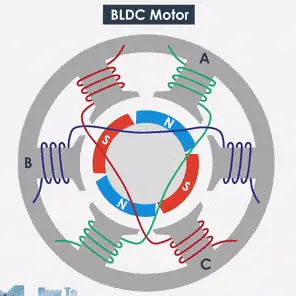- Commutation principle of brushless DC motor
A brushless DC motors are an electric motor with multiple permanent magnets on its rotor and multiple sets of windings on its stator. The speed and direction of the motor are controlled by controlling the direction and size of the current through an electronic speed regulator. Since the brushless DC motor does not require a mechanical commutator, it can achieve the advantages of high efficiency, low noise, and long life. However, when the speed is high, the load is large, or the load changes suddenly, the reverse direction of the commutation current is required, otherwise the motor will not work properly. The commutation principle of the brushless DC motor is to use the Hall sensor or electric speed regulator inside the motor to control the direction and magnitude of the current, thereby realizing the commutation of the motor.
2. Commonly used brushless DC motor commutation methods
2.1 Hall sensor commutation
Hall sensors for brushless DC motors are divided into three types: single-axis Hall sensors, three-axis Hall sensors and linear Hall sensors. These sensors can measure the position and speed of motor rotation, thereby controlling the direction and magnitude of the current to achieve motor commutation. The specific implementation method is: when the motor moves, the Hall sensor detects the change in the magnetic field and sends the signal to the ESC control chip, which is processed in the chip and drives the power sensor to output to the motor. Make sure the coils are positioned correctly so the motor operates properly. Hall sensor commutation has the advantages of simple structure and low cost, and is suitable for low-power motors.

2.2 Electric speed regulator reversal
The electric speed regulator uses the back electromotive force principle in the DC motor to control the commutation of the motor by adjusting the direction and magnitude of the current. During reversal, the ESC control chip will automatically determine the front and rear position of the motor and the direction of the magnetic field, and control and adjust the current direction to achieve the running direction of the motor. Compared with Hall sensor commutation, electric speed regulator commutation does not require external sensors, making the design more flexible. However, electric speed regulator commutation also has some shortcomings, such as complex structure and high price.
Discussions
Become a Hackaday.io Member
Create an account to leave a comment. Already have an account? Log In.